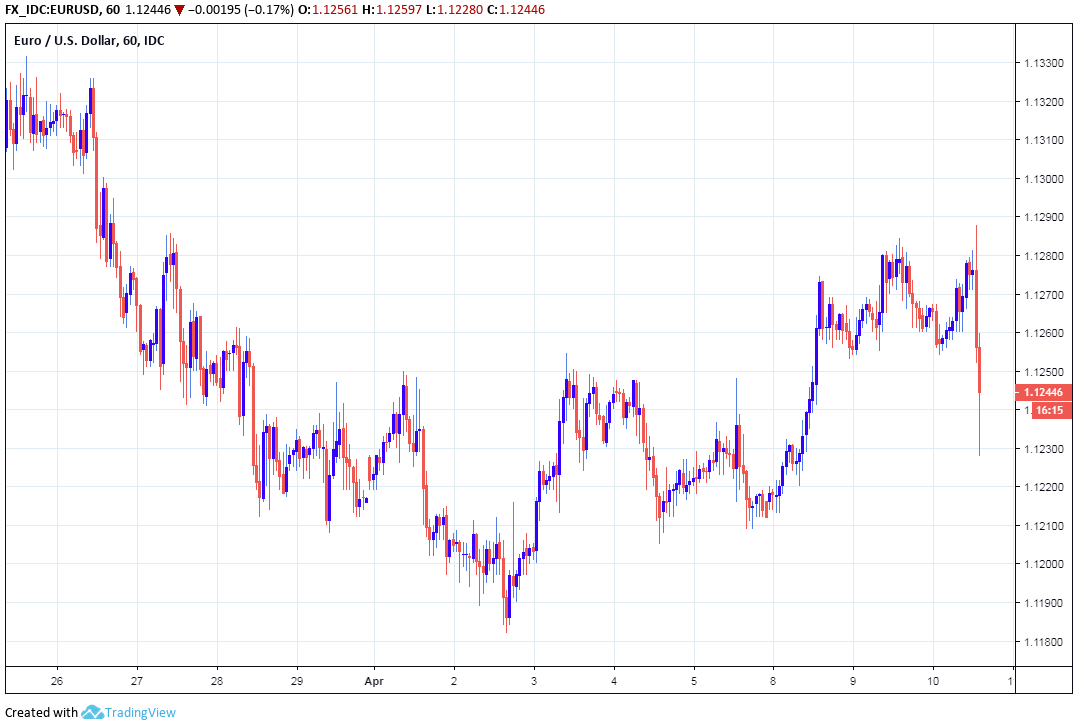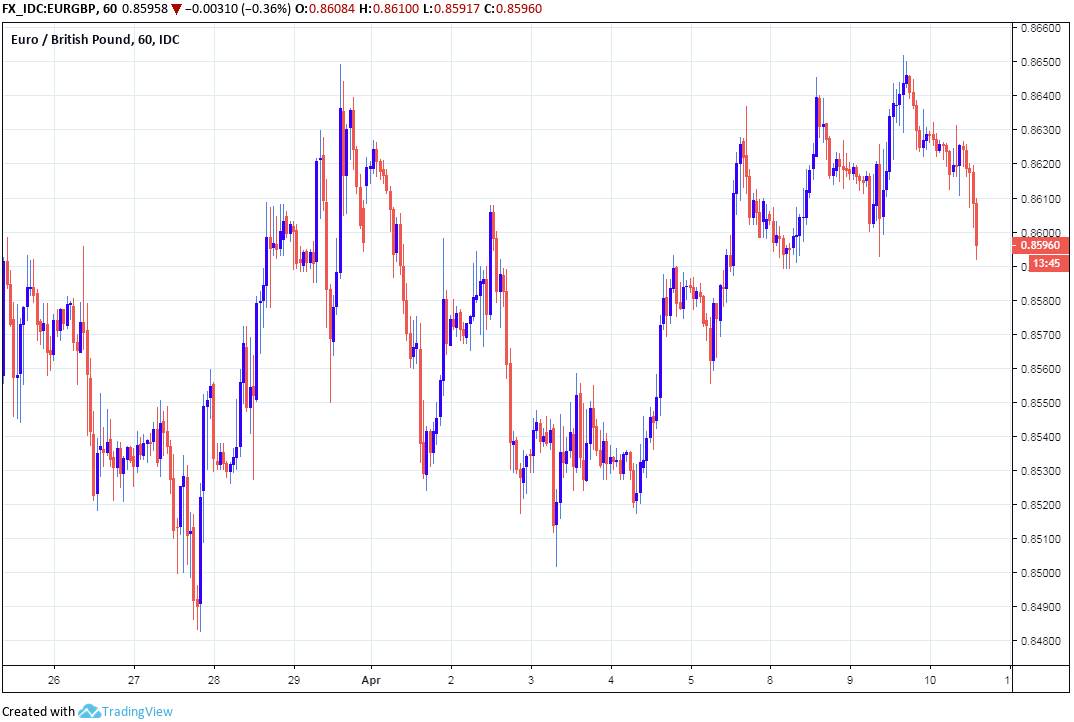EUR/USD Falls after ECB says Slowdown Extended into 2019 and Warns of Lower Inflation to Come
- Written by: James Skinner
 © European Central Bank, reproduced under CC licensing
© European Central Bank, reproduced under CC licensing
- EUR slides after ECB warns of growth slowdown and inflation falls.
- ECB says to give details of cheap loans, rate changes, later in 2019.
- For now, Euro remains humbled by ECB policy as market eyes Fed.
The Euro fell Wednesday after the European Central Bank (ECB) said the Eurozone economy is likely to have slowed further in the New Year and warned that inflation could fall even more than it already has over the coming months.
The European Central Bank left the refinancing rate, marginal lending rate and deposit rate unchanged at 0%, 0.25% and -0.4% respectively on Wednesday, before reiterating that rates will remain at current levels until "at least through the end of 2019."
ECB President Mario Draghi confirmed the bank will launch another round of targeted-long-term-refinancing-operations (TLTROs) in September as part of an effort to stimulate demand in the hope of lifting inflation back toward the target of "close to but below 2%", but said nothing about the details of the programme.
Those TLTROs will see commercial banks provided with super cheap funding in order to suport lending to companies and consumers, although analysts have been sceptical of the idea that they'll even come close to lifting the economy.
It's not yet known how cheap the TLTRO funding will be, although the ECB has already said the terms will be just two years long when its previous round of TLTROs ran for four years.
Draghi also gave no clues about possible ECB measures to mitigate the adverse impact that its negative deposit rate is having on the profitability of commercial banks, but did say the ECB would outline its thinking on the subject later this year.
"After the March action, the ECB took it a bit easier today. The ECB first wants to spend more time in the study room before announcing details of the new TLTROs or even presenting measures to bring relief to the banks," says Carsten Brzeski, chief economist at ING Germany.
Analysts had previously suggested the ECB might soon introduce changes to its interest rate structure so as to provide relief for profitability-challenged banks, whose margins are often heavily influenced by the bank's main interest rates.
"Incoming data continue to be weak, especially for the manufacturing sector, mainly on account of the slowdown in external demand, which has been compounded by some country and sector-specific factors. As the impact of these factors is turning out to be somewhat longer-lasting, the slower growth momentum is expected to extend into the current year," Draghi says.

Above: Euro-to-Dollar rate shown at hourly intervals.
Eurozone GDP growth fell from 2.3% in 2017 to 1.8% in 2018, with much of that deceleration coming during the second half of the year. Some private sector forecasts suggest the economy could grow by as little as 0.9% for 2019, although the European Commission projects a 1.3% expansion.
A recession in the Eurozone manufacturing sector, which has weighed on the manufacturing sector, has been the most significant driver of the slowdown. Most economists attribute that to the U.S. trade war with China and fears over the impact of a possible "no deal Brexit" later taking place later this year.
Since March, official figures have shown industrial production rebounding from a winter slump in Germany, France and Italyh. However, those numbers followed a months-long decline in output and the latest IHS Markit PMI survey suggested the recession in the manufacturing sector deepened during the first quarter.
This weak economic pulse is undermining the outlook for Eurozone inflation, which is key to the European Central Bank interest rate outlook. The ECB is targeting inflation that is sustainably "close to but below 2%", but both headline and core measures of inflation have spent much of the time since the 2012 debt crisis well below that level.
"Headline inflation is likely to decline over the coming months," Draghi told reporters on Wednesday. "Measures of underlying inflation remain generally muted. But measures of labour cost pressures have strengthened and broadened."
After reaching 2.2% in 2018 amid a steep climb in oil prices, the consumer price index fell from 1.5% to 1.4% in March 2019. Core inflation, which most economists say is a better measure of true price pressures in an economy, fell from 1% to 0.8% that month, its lowest level since March 2017.
Core inflation has not been above the 1.2% ever since the Eurozone debt crisis, but until the target can be achieved in a sustainable manner, markets will have little chance of seeing a European Central Bank interest rate hike.
"The president’s statement was dovish as ever," says Claus Vistesen, chief Eurozone economist at Pantheon Macroeconomics. "Whatever we think about the ECB’s ability to actually reach its target, the key message is that the central bank will keep trying, implying an overall dovish policy setting."

Above: Euro-to-Pound rate shown at hourly intervals.
Markets care about the European Central Bank decision because changes in interest rates, as well as the outlook for them, can have a significant influence over international capital flows as well as speculative short-term trading activity.
Interest rate decisions are normally only made in accordance with the outlook for inflation, which is largely a function of economic supply and demand pressures. Higher rates are used to reduce price pressures in an economy while lower rates are thought to lift activity and prices by stimulating demand for credit.
The European Central Bank has been trapped in crisis-fighting mode ever since the Eurozone debt crisis that reached a crescendo in late 2012 because inflation and growth pressures have been so persistently weak.
"Even though the late Easter effect distorted the inflation rate in March to the downside, it is a stretch to argue that the convergence of inflation towards the 2% target is “delayed rather than derailed” as ECB President Mario Draghi put it a few weeks ago," says Florian Hense, an economist at Berenberg.
The Euro-to-Pound rate was -0.24% lower at 0.8609 following the press conference on Wednesday, after extending an earlier -0.13% loss.
The Euro was -0.04% lower at 1.1259 against the Dollar after more than reversing a 0.08% gain.
The EUR/GBP rate has fallen -4.2% so far this year while the Euro-to-Dollar rate is -1.8% lower for 2019.
Time to move your money? Get 3-5% more currency than your bank would offer by using the services of foreign exchange specialists at RationalFX. A specialist broker can deliver you an exchange rate closer to the real market rate, thereby saving you substantial quantities of currency. Find out more here.
* Advertisement




